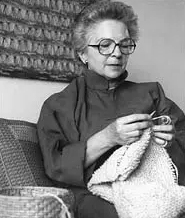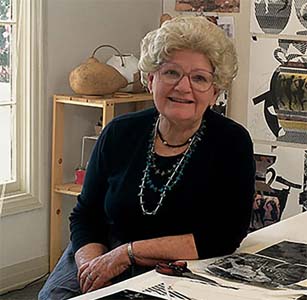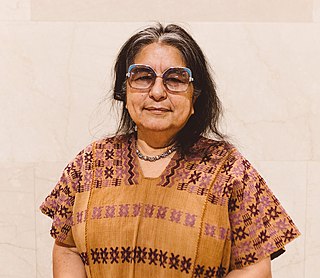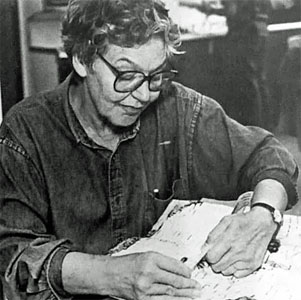
Wearable art, also known as Artwear or "art to wear", refers to art pieces in the shape of clothing or jewellery pieces. These pieces are usually handmade, and are produced only once or as a very limited series. Pieces of clothing are often made with fibrous materials and traditional techniques such as crochet, knitting, quilting, but may also include plastic sheeting, metals, paper, and more. While the making of any article of clothing or other wearable object typically involves aesthetic considerations, the term wearable art implies that the work is intended to be accepted as an artistic creation or statement. Wearable art is meant to draw attention while it is being displayed, modeled or used in performances. Pieces may be sold and exhibited.

Mary Walker Phillips, was an American textile artist, author and educator. She revolutionized the craft of hand knitting by exploring knitting as an independent art form. Her hand-knit tapestries and other creative pieces are exhibited in museums in the U.S. and Europe. She was honored as a fellow by the American Craft Council (ACC) in 1978.

Ideas from mathematics have been used as inspiration for fiber arts including quilt making, knitting, cross-stitch, crochet, embroidery and weaving. A wide range of mathematical concepts have been used as inspiration including topology, graph theory, number theory and algebra. Some techniques such as counted-thread embroidery are naturally geometrical; other kinds of textile provide a ready means for the colorful physical expression of mathematical concepts.
Arline Fisch is an American artist and educator. She is known for her work as a metalsmith and jeweler, pioneering the use of textile processes from crochet, knitting, plaiting, and weaving in her work in metal. She developed groundbreaking techniques for incorporating metal wire and other materials into her jewelry.

A potholder is a piece of textile or silicone used to cover the hand when holding hot kitchen cooking equipment, like pots and pans. They are frequently made of polyester and/or cotton. Crocheted potholders can be made out of cotton yarn as a craft project/folk art.

Agata Oleksiak, known as Olek, is a Polish artist who is based in New York City. Their works include sculptures, installations such as crocheted bicycles, inflatables, performance pieces, and fiber art. They have covered buildings, sculptures, people, and an apartment with crochet and have exhibited in the United States, United Kingdom, Germany, Brazil, Turkey, France, Italy, Poland, and Costa Rica.

Rosanne Somerson is an American-born woodworker, furniture designer/maker, educator, and former President of Rhode Island School of Design (RISD). An artist connected with the early years of the Studio Furniture, her work and career have been influential to the field.

Katherine Westphal was an American textile designer and fiber artist who helped to establish quilting as a fine art form.

Joyce J. Scott is an African-American artist, sculptor, quilter, performance artist, installation artist, print-maker, lecturer and educator. Named a MacArthur Fellow in 2016, and a Smithsonian Visionary Artist in 2019, Scott is best known for her figurative sculptures and jewelry using free form, off-loom beadweaving techniques, similar to a peyote stitch. Each piece is often constructed using thousands of glass seed beads or pony beads, and sometimes other found objects or materials such as glass, quilting and leather. In 2018, she was hailed for working in new medium — a mixture of soil, clay, straw, and cement — for a sculpture meant to disintegrate and return to the earth. Scott is influenced by a variety of diverse cultures, including Native American and African traditions, Mexican, Czech, and Russian beadwork, illustration and comic books, and pop culture.
Cynthia Schira is an American textile artist and former university professor. Her work is represented in the collections of many major public museums.

Sophie Tatum LaCroix was an American handcrafts designer, editor and author of 18 books on crochet, tatting, beadwork, quilting, needlework and embroidery in the early 1900s.
Cat Mazza is an American textile artist. Her practice combines tactical media, activism, craft-based art making and animation in a form that has frequently been described as craftivism. She is the founder of the craftivist collective microRevolt. Mazza is an associate professor of art at the University of Massachusetts Boston.

Lia Cook is an American fiber artist noted for her work combining weaving with photography, painting, and digital technology. She lives and works in Berkeley, California, and is known for her weavings which expanded the traditional boundaries of textile arts. She has been a professor at California College of the Arts since 1976.
L.J. Roberts is an American textile artist. Roberts, who is genderqueer and uses singular they pronouns, explores queer and feminist politics in their work.
Liz Collins is an American contemporary artist and designer. She is recognized for her artwork involving fabric, knitwear, and textiles, as well for the fashion label she developed. She has expertise in textile media including the transition of fabric into multi-dimensional forms as a method to vary the scale of her pieces to make them architectural and inviting rather than object-based. Collins is based in Brooklyn, New York.

The Tempestry Project is a collaborative fiber arts project that presents global warming data in visual form through knitted or crocheted artwork. The project is part of a larger "data art" movement and the developing field of climate change art, which seeks to exploit the human tendency to value personal experience over data by creating accessible experiential representations of the data.

Consuelo Jiménez Underwood is an American fiber artist, known for her pieces that focus on immigration issues. She is an indigenous Chicana currently based in Cupertino, California. As an artist she works with textiles in attempt to unify her American roots with her Mexican Indigenous ones, along with trying to convey the same for other multicultural people.

Lillian Wolock Elliott was an American fiber artist, and textile designer. She is known for her innovative basket craft.
Sharon Kerry-Harlan is an African-American artist active in Hollywood, Florida and Wauwatosa, Wisconsin who is known for her textile art.
Janet Lipkin is an American clothing designer, visual artist and educator. She is known for her crocheted and mixed media apparel and is a leading figure in the Artwear movement from the 1970s and 1980s. Lipkin also works in textile art, painting, and printmaking. She lives in the San Francisco Bay Area in Richmond, California.













